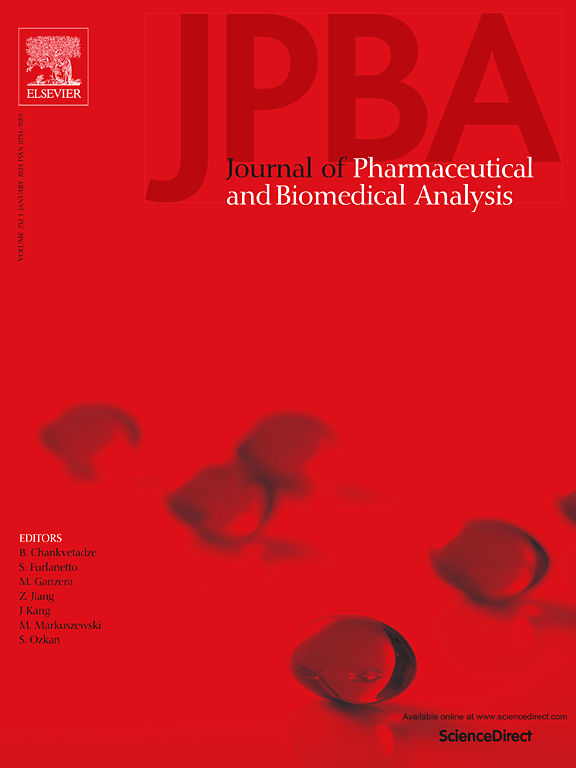Proteomic and network pharmacology analyses reveal S100A8 as the anti-inflammatory target of Yunpi Jiedu Tongluo Qushi Granule in the treatment of rheumatoid arthritis
IF 3.1
3区 医学
Q2 CHEMISTRY, ANALYTICAL
Journal of pharmaceutical and biomedical analysis
Pub Date : 2024-10-15
DOI:10.1016/j.jpba.2024.116522
引用次数: 0
Abstract
Rheumatoid arthritis (RA) is a chronic systemic autoimmune disease characterized by synovial inflammation. RA has a global prevalence between 0.5 % and 1 % although its pathogenesis is not completely understood. Chinese herbal medicine such as Yunpi Jiedu Tongluo Qushi Granule (YJTQG) is one of the treatments for RA. However, the underlying mechanism of action is unclear. Here, analysis of clinical samples reveals that YJTQG can reduce the inflammatory factors and alleviate the symptoms of RA patients. Quantitative proteomic analysis of serum proteomes of RA patients identifies the potential therapeutic targets of YJTQG. We use biochemical experiments to validate several differentially expressed proteins, discover S100A8 as a possible therapeutic target of YJTQG, and analyze the correlation between S100A8 and several known RA biomarkers. Network pharmacology analysis discloses COX1/2 and NOS2 as potential targets of key compounds in YJTQG and protein-protein interaction network analysis reveals TNFα, IL-6, and STAT3 as possible core targets of YJTQG. Bioinformatic and patient sample analyses indicate that YJTQG may reduce S100A8 expression by suppressing its transcription. Mechanistically, we find that kaempferol and quercetin in YJTQG may reduce the expression of S100A8 by inhibiting the phosphorylation, nuclear translocation, and transcriptional activity of p65 in the lipopolysaccharide-stimulated RAW264.7 cells. Therefore, our work demonstrates that S100A8 is a potential therapeutic target of YJTQG for RA, which may provide a new direction for developing new treatments for RA patients.
蛋白质组学和网络药理学分析揭示了S100A8是云皮解毒通络芪颗粒治疗类风湿性关节炎的抗炎靶点。
类风湿性关节炎(RA)是一种以滑膜炎症为特征的慢性全身性自身免疫疾病。类风湿关节炎在全球的发病率在 0.5 % 到 1 % 之间,但其发病机制尚未完全明了。云皮接骨通络颗粒(YJTQG)等中药是治疗 RA 的方法之一。然而,其作用机制尚不清楚。本文对临床样本的分析表明,云皮解毒通络颗粒能减少炎症因子,缓解 RA 患者的症状。对 RA 患者血清蛋白质组的定量蛋白质组分析确定了 YJTQG 的潜在治疗靶点。我们利用生化实验验证了几种差异表达的蛋白质,发现 S100A8 可能是 YJTQG 的治疗靶点,并分析了 S100A8 与几种已知 RA 生物标志物之间的相关性。网络药理学分析显示,COX1/2和NOS2是YJTQG中关键化合物的潜在靶点,而蛋白-蛋白相互作用网络分析显示,TNFα、IL-6和STAT3可能是YJTQG的核心靶点。生物信息学和患者样本分析表明,YJTQG 可通过抑制 S100A8 的转录来降低其表达。从机理上讲,我们发现 YJTQG 中的山奈酚和槲皮素可通过抑制脂多糖刺激的 RAW264.7 细胞中 p65 的磷酸化、核转位和转录活性来降低 S100A8 的表达。因此,我们的研究表明S100A8是YJTQG治疗RA的潜在靶点,这为开发RA患者的新疗法提供了新的方向。
本文章由计算机程序翻译,如有差异,请以英文原文为准。
求助全文
约1分钟内获得全文
求助全文
来源期刊
CiteScore
6.70
自引率
5.90%
发文量
588
审稿时长
37 days
期刊介绍:
This journal is an international medium directed towards the needs of academic, clinical, government and industrial analysis by publishing original research reports and critical reviews on pharmaceutical and biomedical analysis. It covers the interdisciplinary aspects of analysis in the pharmaceutical, biomedical and clinical sciences, including developments in analytical methodology, instrumentation, computation and interpretation. Submissions on novel applications focusing on drug purity and stability studies, pharmacokinetics, therapeutic monitoring, metabolic profiling; drug-related aspects of analytical biochemistry and forensic toxicology; quality assurance in the pharmaceutical industry are also welcome.
Studies from areas of well established and poorly selective methods, such as UV-VIS spectrophotometry (including derivative and multi-wavelength measurements), basic electroanalytical (potentiometric, polarographic and voltammetric) methods, fluorimetry, flow-injection analysis, etc. are accepted for publication in exceptional cases only, if a unique and substantial advantage over presently known systems is demonstrated. The same applies to the assay of simple drug formulations by any kind of methods and the determination of drugs in biological samples based merely on spiked samples. Drug purity/stability studies should contain information on the structure elucidation of the impurities/degradants.

 求助内容:
求助内容: 应助结果提醒方式:
应助结果提醒方式:


